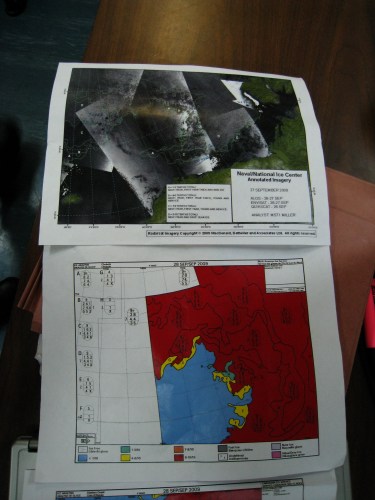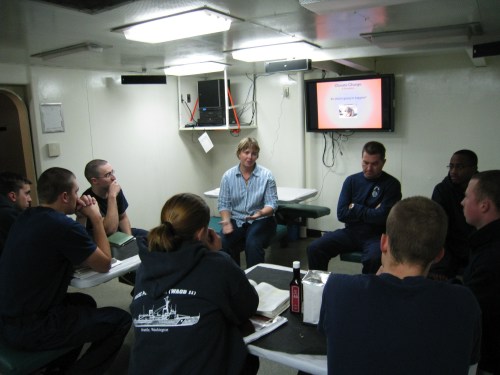Location: Lat: 73.1575 N Long: -154.279 W
In the morning, we were finally close to the GPS location of the first bear. When I went to bridge, we could finally see a bit more ice. As the boat hits some of the bigger pieces, the boat shakes. Coming from California, my first instinct was earthquake for the first few time we hit a piece of ice - and then I remembered that I am on a boat in the middle of the Arctic Ocean!
 The Polar Sea is a powerful ship. You can see the path that it broke through the ice.
The Polar Sea is a powerful ship. You can see the path that it broke through the ice.
After breakfast, the team of researchers got together all their gear in preparation for heading out in the helicopter to find and collect data on the first bear. In order to fly several safety steps have to happen. First, a flight briefing happens on the bridge with all the involved parties going over the details and doing a risk assessment. Then the team has to put on their safety gear. Next to their skin, they have to wear Nomex long underwear. Nomex is a fire resistant material just in case of an issue with the helicopter. Also, since they are flying over open water, each person must wear a life jacket. During this time, all of the Coasties are preparing as well. There are several different teams all wearing different colors to indicate their role in the process. Once all is ready to go, then the helicopter can be loaded and take off!
 Eric Regehr getting ready to head out on the helicopter for the first bear capture.
Eric Regehr getting ready to head out on the helicopter for the first bear capture.
 Dr. Merav Ben-David, chief scientist, has made sure to put on her safety flotation device before getting onto the helicopter.
Dr. Merav Ben-David, chief scientist, has made sure to put on her safety flotation device before getting onto the helicopter.
 Our fantastic helicopter pilots who keep us all safe!
Our fantastic helicopter pilots who keep us all safe!
 John Whiteman and Harry Harlow, the other two key scientist for the polar project. You'll notice that John is wearing a white t-shirt. This is part of the safety gear called Nomex which is a fire resistant material.
John Whiteman and Harry Harlow, the other two key scientist for the polar project. You'll notice that John is wearing a white t-shirt. This is part of the safety gear called Nomex which is a fire resistant material.
 A team of Coasties prepared to support the helicopter team in case of emergency. They are decked out in reflective tape!
A team of Coasties prepared to support the helicopter team in case of emergency. They are decked out in reflective tape!
 Taking off in search of polar bears for the first time!
Taking off in search of polar bears for the first time!
About an hour after the team took off, we got word that they were returning to the ship. It turns out that the bear was no longer in the location that it was last tracked on GPS. The bears can travel many miles in a single day and we only get updates on their locations once a day. The radio transmitter was also not working to track the bear. This is most likely because the bear was swimming. The transmitters do not work well while in salt water. Also, the team found that there were no pieces of ice big enough to land the helicopter on or work on for data collection. Everyone was surprised to find so little ice near our location. The team reconvened and reanalyzed the data using new images of the ice. Using that information, we have decided to head north west a few hundred miles off the coast of Wrangle Island, Russia. There are three bears who are located in that area and there appears to be more ice in that area. Wrangle Island is a big Russian federal nature res erve and has a large polar bear denning area.
 Maps that show ice data that we are using to make decisions about where to travel next.
Maps that show ice data that we are using to make decisions about where to travel next.
In the afternoon, I joined in an interview with the Captain of the ship. A few times a week, I will be highlighting one of the Coast Guard crew who have been fantastic in supporting this mission. I found it only fitting to start with the Captain!
Polar Profile: Captain David Vaughn joined the Coast Guard Academy 27 years ago, directly out of high school. He joined because he really wanted a career that he could help people. His first tour was on a World War Two icebreaker ship and he completely fell in love with ice. During his 27 years of service, he has been on five different icebreaker ships and travelled all over the world. He has been lucky enough to see over 20 polar bears during his time on the ice, but is still looking forward to seei੮ g one on this trip. He has also been able to see some of the changes first hand to the sea ice. It overall he has noticed a decrease in the amount of sea ice in the arctic.
Captain Vaughn has been excited to see that the Polar Sea would be used for science again. It has not been used in many years; it is an older boat, but very powerful and stable when facing some of the thicker ice we anticipate on hitting later in the trip. In fact, when all the turbines are going, the boat has about 60,000 horsepower of power. It can ram through up to 21 feet of ice! Another amazing ship fact - it can hold 1.3 MILLION gallons of fuel!
The Captain exudes a sense of calm, which is important when faced with a challenging environment like the Arctic Ocean. He gave a great analogy for how the tries to behave during challenges - like a duck who is calm above the water, but underneath who's feet are going crazy. One of the way he deals with the challenging environment is by having a larger crew. If something goes wrong out in the Arctic, it's at times impossible to get to shore to fix it, so he needs to have the people power on board to resolve the problems. A great example is the steering problem I mentioned before.
 Captain Vaughn during his interview for National Geographic.
Captain Vaughn during his interview for National Geographic.
 The quarters of the captain. He works hard to keep us all safe and deal with any problems that might arise.
The quarters of the captain. He works hard to keep us all safe and deal with any problems that might arise.
 Not only can Captain Vaughn be in charge of all the crew, but he also rocked the ping pong tournament during the last trip.
Not only can Captain Vaughn be in charge of all the crew, but he also rocked the ping pong tournament during the last trip.
Tonight (just before Bingo Night), I was able to sit-in on an Earth Science class. I learned that there is another teacher on board, Erin Sheridan. She was brought on to teach four classes to any Coasties who are interested in earning college credits. She offers classes based on interest and on her skills; they are Earth Science, Intermediate Oceanography, Beginning Algebra and Intermediate Algebra. I was lucky enough to sit in on her class about climate change (and she gave me great resources to use in my classroom!). The Coasties in her class asked really great questions about evidence for climate change and possibilities for the effects of climate change. I also learned that if the students get high grades in her class, there is a chance that the Coast Guard will pay for the class. What a great opportunity to work towards a bachelors degree while still completing their tour of duty!
 Erin Sheridan teaching an Earth Science on board the ship for the Coasties. They can earn college credits while on tour.
Erin Sheridan teaching an Earth Science on board the ship for the Coasties. They can earn college credits while on tour.
Random Boat Fact of the Day:
 These tools are in case of electrocution emergency. The yellow hook is made of plastic to pull someone away. The contraption on the right is called the 'Dead Man's Stick' - it grounds the electricity.
These tools are in case of electrocution emergency. The yellow hook is made of plastic to pull someone away. The contraption on the right is called the 'Dead Man's Stick' - it grounds the electricity.
Lastly, I also have the first "Sounds of the Arctic" challenge prepared for you. Listen to the following sound clip and take a guess as to what you think it might be. Check back in tomorrow to find out the answer!

